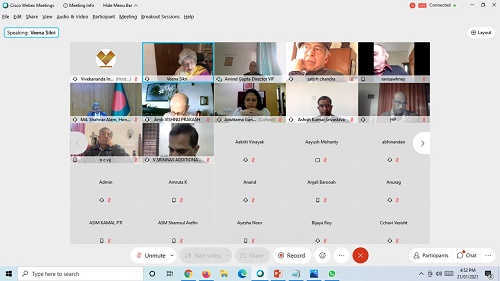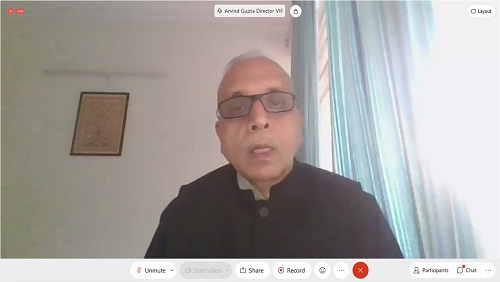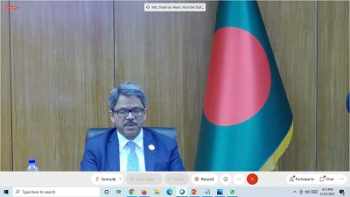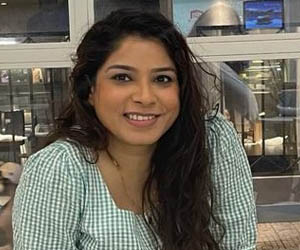On 21 January 2021, the Vivekananda International Foundation (VIF) organised VIMRASH on India-Bangladesh Relations: Opportunities and Challenges. Dr Arvind Gupta, Director VIF, introduced Md. Shahriar Alam, M.P. State Minister for Foreign Affairs, Government of Bangladesh and gave opening remarks. Dr Gupta stated that India-Bangladesh relations are diversified and strategic, and in the last decade are in their golden phase of the relationship. Both countries have successfully resolved border and security related issues andfixed their maritime boundaries. Bangladesh is India’s biggest trade partner in South Asia. The two countries are also cooperating in building connectivity to fulfil its goals of Neighbourhood first policy. India-Bangladesh relations act as a positive force for regional integration and should have strategic dialogues on global and regional development.
Md. Alam appreciated the multifaceted and multidimensional relationship of the two countries. The two countries are geographically contiguous and share common ecosystems such as forests and seas. Their relations are rooted in history and tradition. The genesis of their relations lay in War of Liberation in 1971. India’s contribution to the war is widely appreciated and recognised. In 2012-13, PM Sheikh Hasina started honouring foreign friends in War of Liberation, whose work is continuing. The year 2021 marks the birth centenary of nation’s father, Sheikh Mujibur Rahman, and the golden jubilee of Independence of Bangladesh. Their shared commitment to peace and security has helped attain tangible results in various areas, such as resolving land and maritime boundaries, energy, telecommunications, ICT and many more. Their mature relationship has built confidence and trust.

Despite global challenges, the two countries have strengthened the relationship between mutual benefits and shared future, forward-looking strategy with remarkable social progress. The visit of Indian PM Modi to Dhaka in June 2016, and visit of Bangladesh PM Sheikh Hasina in 2017 and 2019 to Delhi were the landmark events in building ties. On 17 December 2020, a virtual summit was conducted exploring the possibility of expanding bilateral relations to new areas, such as Artificial Intelligence, outer space and renewable energy. At present, 19 instruments of bilateral cooperation exist thereby relations have evolved into a mature one, confidence and trust.
Further, a strong and vibrant India offers immense opportunities for Bangladesh to develop, and Bangladesh is projected to be the second largest economy in South Asia, after India. To reap the benefits of the opportunities, it is important to synergise their efforts in the field of trade, investment that will bring mutual benefits. The volume of trade is over ten million dollars; however, the balance of trade favours India. There exist enormous opportunities together as the two countries exchange their workers and experts.
Bangladesh is strategically located between two locations, i.e. Central India and North East India and South Asia and South-East Asia. Therefore, Bangladesh has the advantage of enhancing connectivity projects. Bangladesh has launched numerous infrastructural projects such as Padma multi-purpose bridge, nuclear power plant and many more.
Since the outbreak of COVID-19, economies have faced disruptions. Nevertheless, the Indian government cooperation by providing medicines, protective equipment to Bangladesh was widely appreciated. On 21 January 2021, Indian PM Modi formally donated 2 million Covax doses to Bangladesh. Also, during the pandemic, the two countries facilitated evacuation citizens from both countries.
Md. Alam reiterated Dr Gupta’s views that there is a golden chapter of bilateral relations between India and Bangladesh. The people to people relations are an integral part of the relationship, and therefore we need to nurture these as a catalyst.
The two countries need to focus on priority areas, and should resolve pending issues concerning sharing of waters, resolving continental shelf issue in the Bay of Bengal, bringing down border incidents to zero, and managing the media. Both countries’ political leadership should ensure that the right environment is created for mutual benefit and more prosperous and developed.

Following the talk, there was a discussion on the continuing challenges and opportunities. It was stated that it was important to take advantage of BIMSTEC and BBIN that can assist in social and economic development. Md. Alam stated that PM Modi impetus to revive SAARC during COVID-19 was a positive development. The Liberation War memories were relived and discussed with the presence of veterans in the discussion. The border and security-related cooperation – joint patrol peace in the northeast is the testimony of what the two countries have achieved.
The upturn in India-Bangladesh ties is credited to the efforts of PM Sheikh Hasina. The proposed visit of PM Modi in March 2021 holds new grounds for increasing bilateral relations. There is a need to look at new areas for trade. There can be further cooperation in the blue economy. Another area of cooperation that can be explored is that between academia – scholarships and joint research joint can help establish units of excellence. There is a need to formalise a strategic dialogue, i.e. track one, one and a half and track two diplomacies to discuss sensitive issues like Pakistan, China.
Dr Gupta concluded the discussion stating that India-Bangladesh relations’ have immense potential and new models of cooperation are being discussed. The two countries are looking forward to PM Modi visit to Bangladesh in March 2021. There exist positive relations between the two countries, which are being transformed for the benefit of the region.







Post new comment